DeepArt.io

Neural networks are no stranger to the art world. These networks are used in works such as Ralf Baeker’s, Rechnender Raum (Computing Space) (1) and SymbioticA’s MEART – The Semi-Living Artist. (2) Neural networks are essentially programs that mimic the human brain when it comes to problem-solving. In other words, it’s a system or network […]
PRISM:The Beacon Frame

[video src=https://www.youtube.com/watch?v=ODQbbJPTpDY]Julian Oliver and Danja Vasiliev's Prism: The Beacon Frame, is a series of installations inspired by the formerly secret Prism program that uses similar techniques of wireless device localization and mapping, cell-tower hijacking and wireless packet inspection known to be in deployed by state sanctioned surveillance agencies such as the GCHQ(UK) and NSA(USA). It debuted at Transmediale in Berlin in 2014 and was taken down by the venue for allegedly violating German privacy laws.
Banksy: One Nation, Under CCTV

 One Nation Under CCTV is a graffiti artwork criticizing the use of surveillance by the government. It was created in 2007 and was located on Newman Street in London. It was created by London-based guerilla artist Banksy [1], whose identity remains unknown by the public in 2019. He is known for his satirical, dark, yet political grafitti artwork that he places throughout the world without notice. Banky's work suggests that we are controlled by surveillance and that everything that we do is watched or listened by somebody. Overtime, his artworks are often taken down by the government or destroyed by unknown sources.
One Nation Under CCTV is a graffiti artwork criticizing the use of surveillance by the government. It was created in 2007 and was located on Newman Street in London. It was created by London-based guerilla artist Banksy [1], whose identity remains unknown by the public in 2019. He is known for his satirical, dark, yet political grafitti artwork that he places throughout the world without notice. Banky's work suggests that we are controlled by surveillance and that everything that we do is watched or listened by somebody. Overtime, his artworks are often taken down by the government or destroyed by unknown sources.
Jaywalking
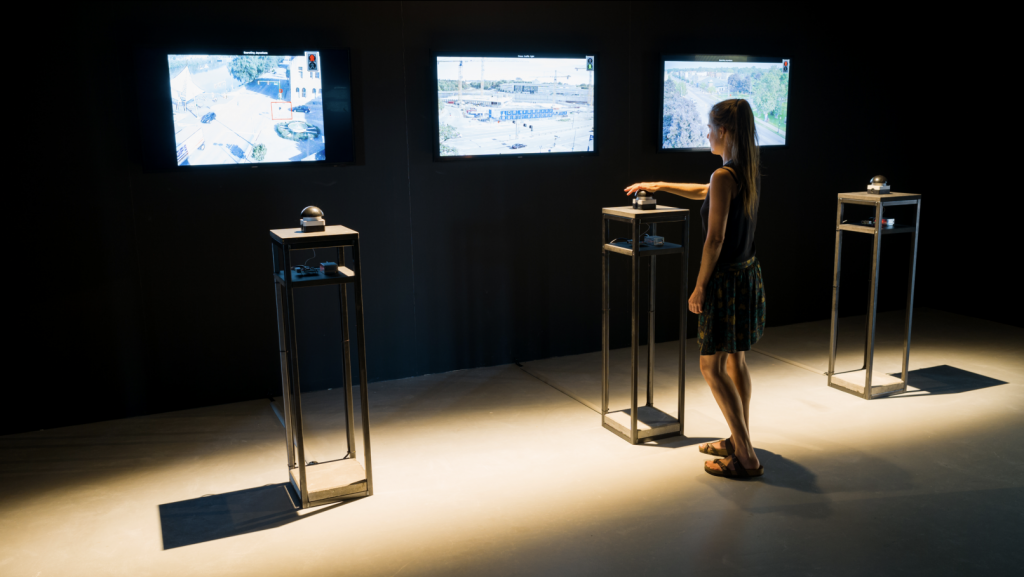
Artist Dries Depoorter’ s Jaywalking is an interactive installation that displays live surveillance footage of streets in various countries. Surveillance webcams capture footage of crosswalks and identify jaywalkers. From the monitor, visitors are given a choice as to whether or not they want to press a button that emails screenshots to local police stations. The work thus presents audiences with a moral dilemma. The ensuing interactions convey a complete disconnect between the surveilled and the installation viewer in charge of their fate.
s Jaywalking is an interactive installation that displays live surveillance footage of streets in various countries. Surveillance webcams capture footage of crosswalks and identify jaywalkers. From the monitor, visitors are given a choice as to whether or not they want to press a button that emails screenshots to local police stations. The work thus presents audiences with a moral dilemma. The ensuing interactions convey a complete disconnect between the surveilled and the installation viewer in charge of their fate.
Nobody Likes Me
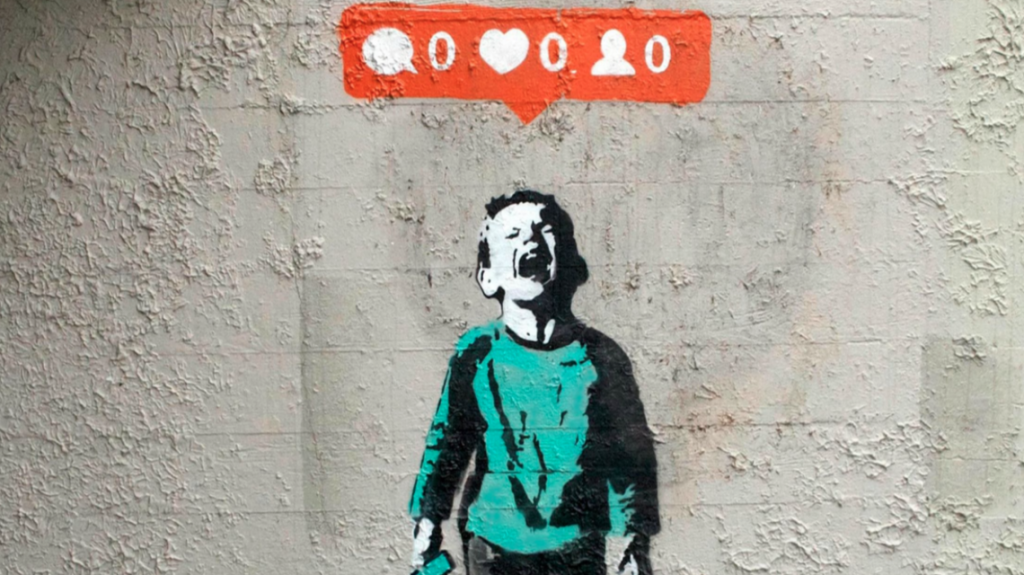
 A Vancouver based artist who goes by the alias of iHeart, has gotten a lot of attention after Banksy, a famous street and graffiti artist, reposted his work on social media. The work in mention depicts a boy who is obviously distraught and weeping uncontrollably. However, what makes this work so interesting as well as places the work into the category of both culture jamming as well as post-internet art, is the little bits of aerosol paint that depicts the instagram logos that indicate the amount of likes, comments that a user has.
A Vancouver based artist who goes by the alias of iHeart, has gotten a lot of attention after Banksy, a famous street and graffiti artist, reposted his work on social media. The work in mention depicts a boy who is obviously distraught and weeping uncontrollably. However, what makes this work so interesting as well as places the work into the category of both culture jamming as well as post-internet art, is the little bits of aerosol paint that depicts the instagram logos that indicate the amount of likes, comments that a user has.
r/place
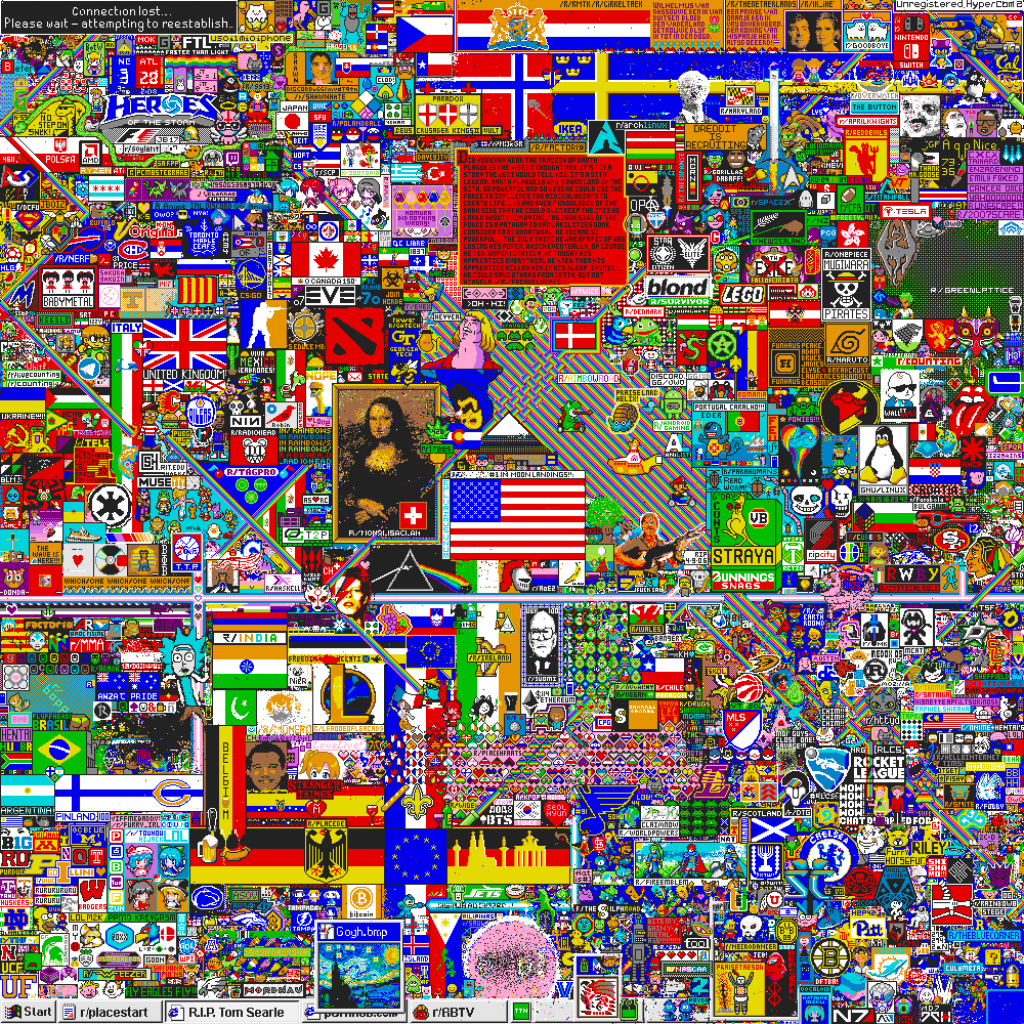
 r/place (pronounced "ar slash place" or simply just "place") is a collaborative art project created by the community of the website Reddit.com in April of 2017. r/place was a grid of one million pixels (1000×1000) that was initially completely white. Anyone with a reddit account could visit http://www.reddit.com/r/place between the first and third of April of 2017. Once there, users could pick a color, and place a single pixel of the chosen color anywhere on the grid, including pixels that other users had already filled in. Users were allowed to place additional pixels five to twenty minutes after each pixel they placed. The page still exists, however users can no longer participate in the project and instead the subreddit is now dedicated to people simply talking about r/place.
r/place (pronounced "ar slash place" or simply just "place") is a collaborative art project created by the community of the website Reddit.com in April of 2017. r/place was a grid of one million pixels (1000×1000) that was initially completely white. Anyone with a reddit account could visit http://www.reddit.com/r/place between the first and third of April of 2017. Once there, users could pick a color, and place a single pixel of the chosen color anywhere on the grid, including pixels that other users had already filled in. Users were allowed to place additional pixels five to twenty minutes after each pixel they placed. The page still exists, however users can no longer participate in the project and instead the subreddit is now dedicated to people simply talking about r/place.
Nests

[video src=https://www.youtube.com/watch?v=gCB9BE5H6B4] Surveillance by governments, corporations, and even other institutions is becoming an epidemic around the world. Prague-based artist Jakub Geltner flips the viewpoint of standard surveillance equipment. Nest positions surveillance equipment such as video cameras and satellite dishes in congested flocks. Located at beaches, elementary schools, buildings, and bridges, amalgamations of up to twenty or so devices are placed within extremely close proximity to each other, pointing every direction. The installations suggest the spreading of an infection or rash, reminding us that in a sense, we are never out of the line of sight; we continually are being watched even when we do not notice.
Home made Virtual Soup
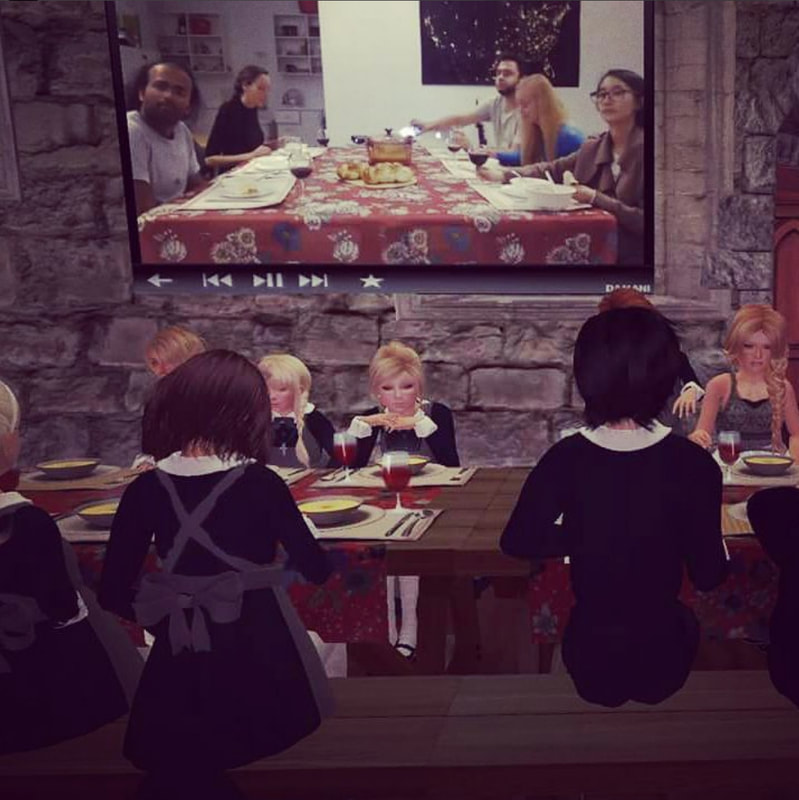
[video src=https://vimeo.com/245388198] Home made Virtual Soup, developed by artist Avital Meshi, connects Second Life avatars and Real-Life puppeteers. The meeting was held during soup time at St. Columba Catholic School in the virtual community Second Life. The artist set up the meeting with Miss Sarah Sandalwood, editor of O’Hare’s Gap, a guide to a 1930s virtual Irish village. Together, Miss Tali (Avital Meshi’s Second Life avatar) and Miss Sarah Sandalwood “opened a mystical portal between” both worlds. The meeting was a wonderful real-time experience where realities collided. The artist invited her “school family” at UCSC to enjoy soup with Second Life students of St. Columba, and they all experienced a “moment of communal fellowship.”
One Beat One Tree
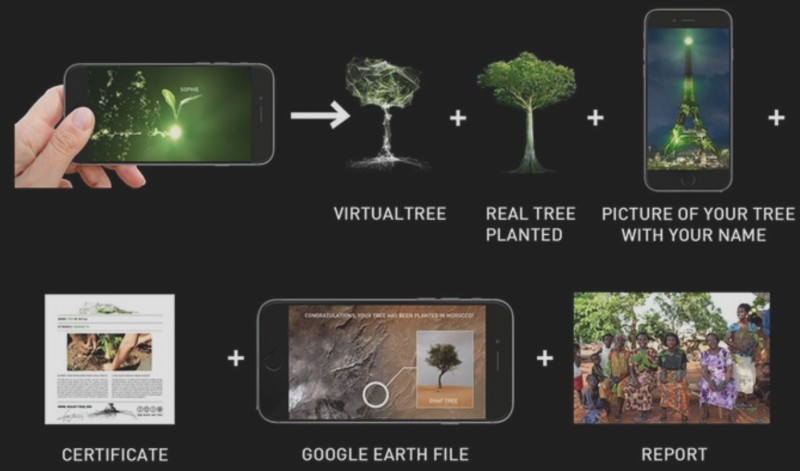
[video src=https://www.youtube.com/watch?v=ie80LvSpIpk align:right height:220]One Beat One Tree by Belgian artist Naziha Mestaoui, displays a world of innovation and technology, and its ability to simulate the spectacle of life as well as growth, in an interactive and heartfelt simulation. The installation consists of a projection of digital forests on cityscapes, bringing the technology as well as the nature into a perceived symbiotic relationship. However, the real magic of this piece comes with the interactive capabilities of this virtual environment, in which the participants are given a heartbeat sensor that syncs with their phones[1], where with each beat, the virtual trees seem to sprout and continue to grow in the virtual space.
Sharing Faces
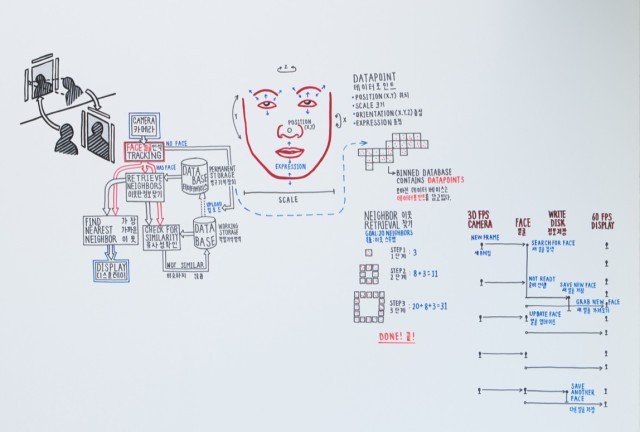
[video src=https://vimeo.com/96549043]Sometimes political and socio-economic issues can act as a veil, automating a blurring or skewing of how people may perceive one another. Many people are taught to hate or disagree with entire populations of others because of past or ongoing sociopolitical issues. Furthermore, this thought process produces stigmas and generalizations that will continue to deepen and push the cultures and people apart, until someone tries to reevaluate the situation. Digital artist Kyle McDonald took this task into his own hands and created an art installation that utilizes high tech surveillance cameras and specially coded software to bring together people from Japan and South Korea to help mend the rocky history between the two countries.
In Order to Control

[video src=https://www.youtube.com/watch?v=Nnq4rvPT4Qc&feature=youtu.be]“What is it to be free? Are you free at all? These are just some of the questions asked to the participants in the interactive installation created by Nota Bene, an Istanbul-based creative studio. The artwork In Order to Control features a continuous loop of digital text sprawled across the floor, littered with moral and ethical questions such as, “Everything that’s legal is not always fair,” and “Everything that’s fair is not always legal.”[2] As spectators step over the sea of Nota Bene’s ethos, their silhouette on the wall takes to life and is transposed with the scrolling typography.
I Promise to Love You
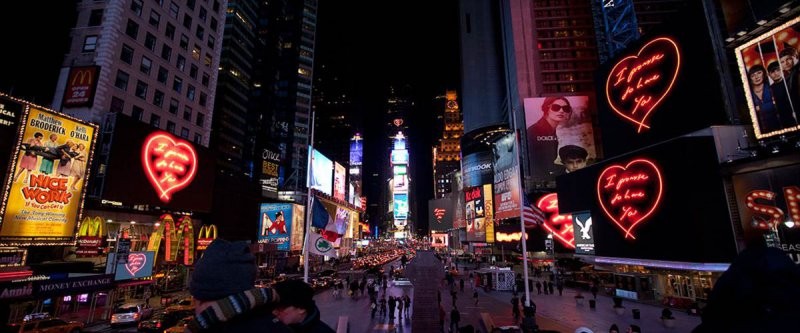
 I Promise to Love You by Tracey Emin is a series of neon artworks, comprised of six written love messages animated on fifteen billboards in Times Square in February 2013., The glowing words slowly spell themselves out, as if being written by a ghost or an invisible presence, demonstrating the power of love.
I Promise to Love You by Tracey Emin is a series of neon artworks, comprised of six written love messages animated on fifteen billboards in Times Square in February 2013., The glowing words slowly spell themselves out, as if being written by a ghost or an invisible presence, demonstrating the power of love.
LOVE

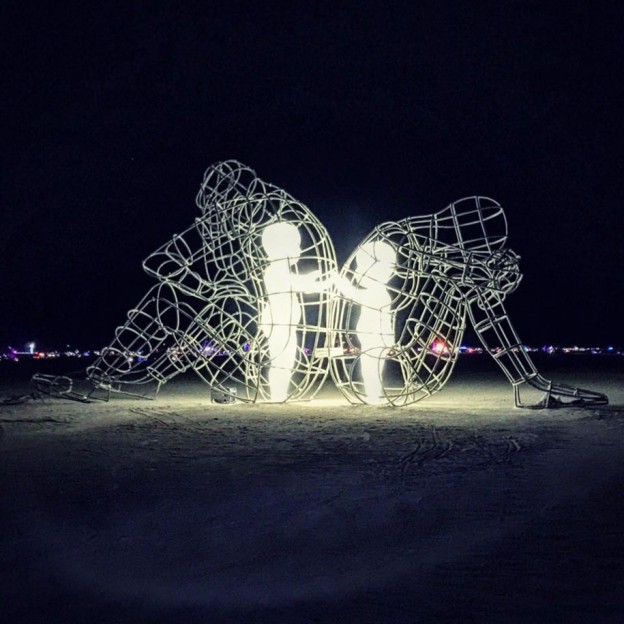 Love is Alexander Milov's debut art piece for the Burning Man Festival. The sculpture calls into question how one is to truly"discover one's genuine self in a media-saturated world." Not only does the sculpture itself send a message to its audience, but the material that is used to create the sculpture is also part of the message as well.The outer figures represent the independence and solitude of adulthood. The rebar cages from which they are fashioned represents how society traps our inner selves. By contrast, the children trapped inside suggested the possibility of connection and illumination.
Love is Alexander Milov's debut art piece for the Burning Man Festival. The sculpture calls into question how one is to truly"discover one's genuine self in a media-saturated world." Not only does the sculpture itself send a message to its audience, but the material that is used to create the sculpture is also part of the message as well.The outer figures represent the independence and solitude of adulthood. The rebar cages from which they are fashioned represents how society traps our inner selves. By contrast, the children trapped inside suggested the possibility of connection and illumination.
Aporia
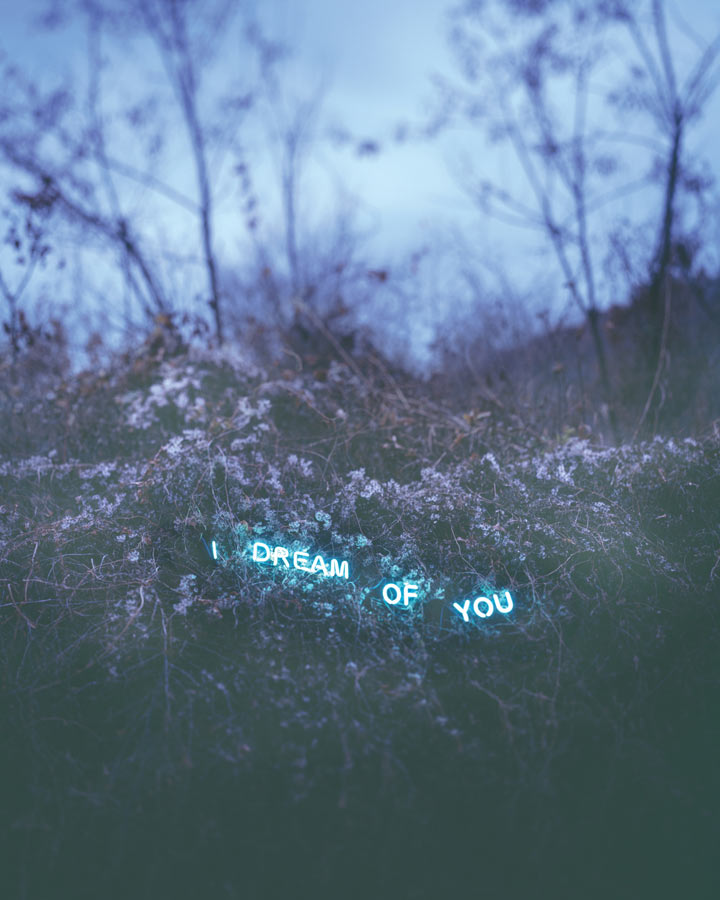
 Aporia is a collection of installations by South Korean artist Lee Jung. Each of the installations consist of a sentence or phrase spelled out in neon against an empty, natural background. The word "aporia" comes from a Greek word meaning "dead end street" and the Oxford English Dictionary defines it as: "An irresolvable internal contradiction or logical disjunction in a text, argument, or theory." The name of the piece combined with the specific matter phrases suggests the artist's complex, if not conflicted, thoughts about the concept of love.
Aporia is a collection of installations by South Korean artist Lee Jung. Each of the installations consist of a sentence or phrase spelled out in neon against an empty, natural background. The word "aporia" comes from a Greek word meaning "dead end street" and the Oxford English Dictionary defines it as: "An irresolvable internal contradiction or logical disjunction in a text, argument, or theory." The name of the piece combined with the specific matter phrases suggests the artist's complex, if not conflicted, thoughts about the concept of love.
We Are All Made of Light
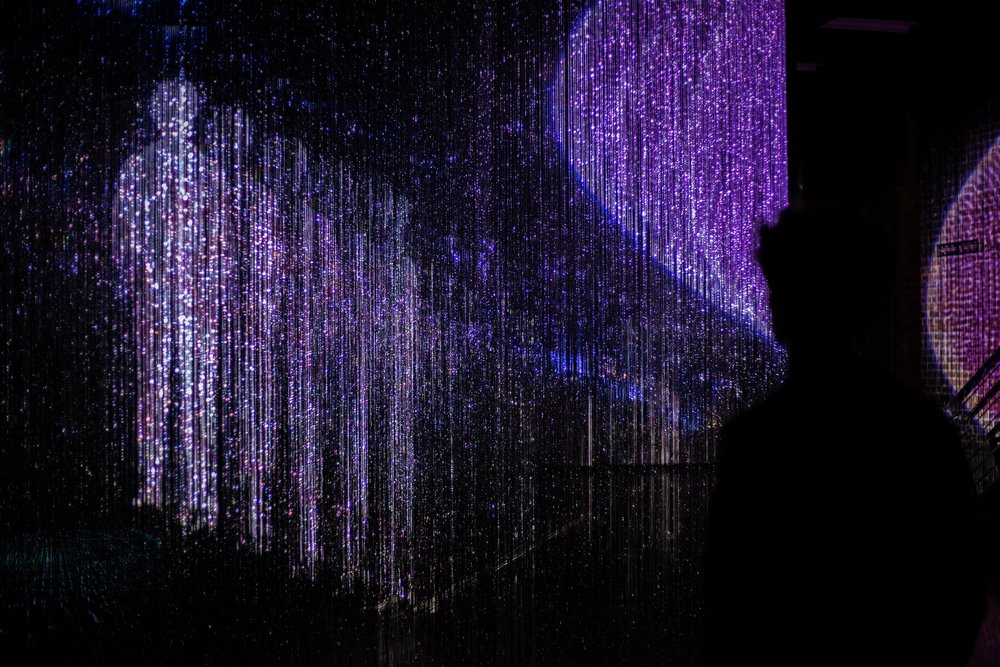
[video src=https://vimeo.com/313413541 height:200 align: left]We Are All Made Of Light is an immersive art exhibition which exemplifies the interconnectedness that we share with our fellow humans and the universe itself. The releasing of the installation coincided with Seattle’s BOREALIS: a festival of light, debuting in October, 2018 in South Lake Union and across Seattle. The work was created by the Seattle-based artist Maja Petrić who set out to demonstrate the thought that we are all just individuals in vast and expansive universe, yet we all share some form of expanded consciousness.
Creative Adversarial Network
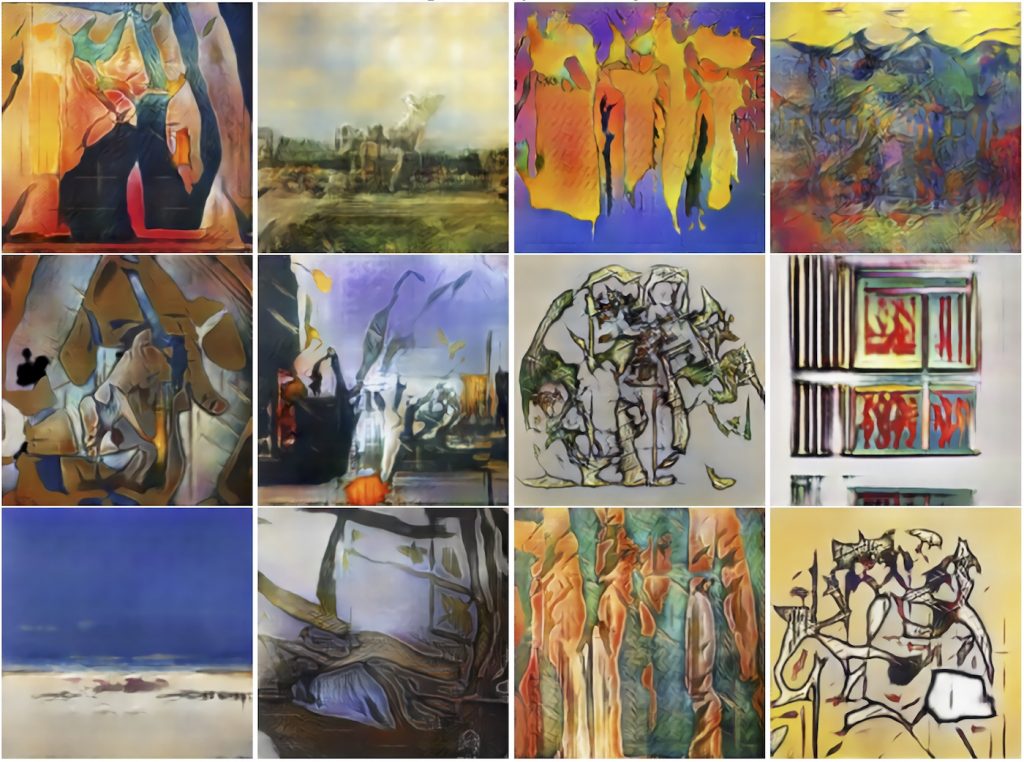
 A computer program called (CAN) Creative Adversarial Network has been making creative works that are being compared with art made by human artists, and it is learning how to continue to improve its works by having people judge them and learning to judge them itself. If a computer can make art on its own will humans artists become obsolete?
A computer program called (CAN) Creative Adversarial Network has been making creative works that are being compared with art made by human artists, and it is learning how to continue to improve its works by having people judge them and learning to judge them itself. If a computer can make art on its own will humans artists become obsolete?
Reusable Universes
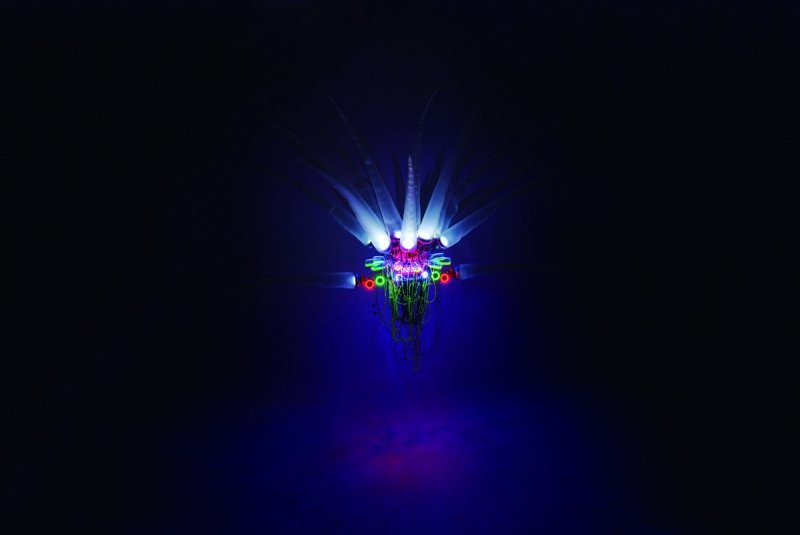
Artist Shih Chieh Huang really takes on the saying of one person’s trash is another person’s treasure, producing some incredible cybernetic structures and sculptures. These sculptures utilize various pieces of plastics, fans, electronics, and circuit building that mimic organic life of deep sea organism. The plastic deep sea animals glow with brilliant lighting, pneumatics, and […]
$8,793 Worth of [Digital] Art
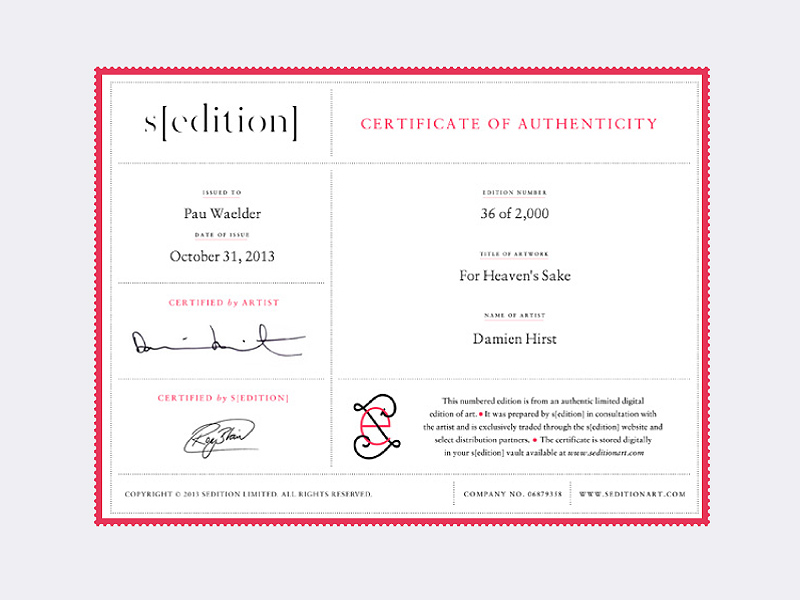
 In art critic Pau Waelder's ebook, titled $8,793 Worth of [Digital] Art, he pairs each of the 159 images of works of art lifted directly from the online art marketplace S[edition]'s storefront with either an authentic or unauthentic "certificate of authenticity," which is intended to only be given upon the official purchase of each copy of an art piece by an individual. However, a simple flaw in the website presentation allowed Waelder to reproduce the certificate – a blank example copy for each art piece is shown on the website proper, which Waelder copied and used to forge some of the certificates in his collection while the rest he officially purchased. These copies are indistinguishable from the real deal, forcing the reader to distrust what they see on the page as fact – an obvious metaphor for what debatably constitutes as "owning an official piece of art" in the contemporary digital landscape.
In art critic Pau Waelder's ebook, titled $8,793 Worth of [Digital] Art, he pairs each of the 159 images of works of art lifted directly from the online art marketplace S[edition]'s storefront with either an authentic or unauthentic "certificate of authenticity," which is intended to only be given upon the official purchase of each copy of an art piece by an individual. However, a simple flaw in the website presentation allowed Waelder to reproduce the certificate – a blank example copy for each art piece is shown on the website proper, which Waelder copied and used to forge some of the certificates in his collection while the rest he officially purchased. These copies are indistinguishable from the real deal, forcing the reader to distrust what they see on the page as fact – an obvious metaphor for what debatably constitutes as "owning an official piece of art" in the contemporary digital landscape.
Indeed, if one were to compare this certificate with any featured on S[edition]'s website, can any difference be found? (Save for the art and artists' names, of course.)
Profession- Animal Communicator
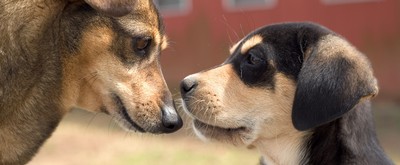
[video src=https://vimeo.com/187329313 height:200 vspace:20 hspace:10 align:left] Communication and telepathy with non-human animals is a subject that has not been extensively researched, but has sparked curiosity in humans. Other animals bring us a wealth of joy and fascination, making it no surprise that alternate ways of communication with them are being developed and explored, due to humans not being able to directly understand non-human animal vocals. Rebecca Loyche’s Profession-Animal Communicator is an experimental video that features overlaid clips of various species of animals including pets as well as wild animals, with a recorded interview from a professional communicator “with over twenty years of experience, estimating that she has done over twenty-four thousand consultations to date.” [1]
Biometric Mirror

[video src=https://youtu.be/Qzs6M0XFyaI height:220 align:left] Lucy McRae's Biometric Mirror is an interactive art installation. Viewers are invited to casually glance into one of the installation’s mirrors, which then runs artificial intelligence software to analyze and “perfect” the patron’s physical facial features. Physical attributes of the face including age, gender, and race are quantified and modified through use of an algorithm to produce a Marquardt Mask, or a more “physically perfect” version of ones face.The participant is therefore shown, face-to-face a simulated version of themselves, a doppelganger that is supposedly better, but eerily "off."
Likeness
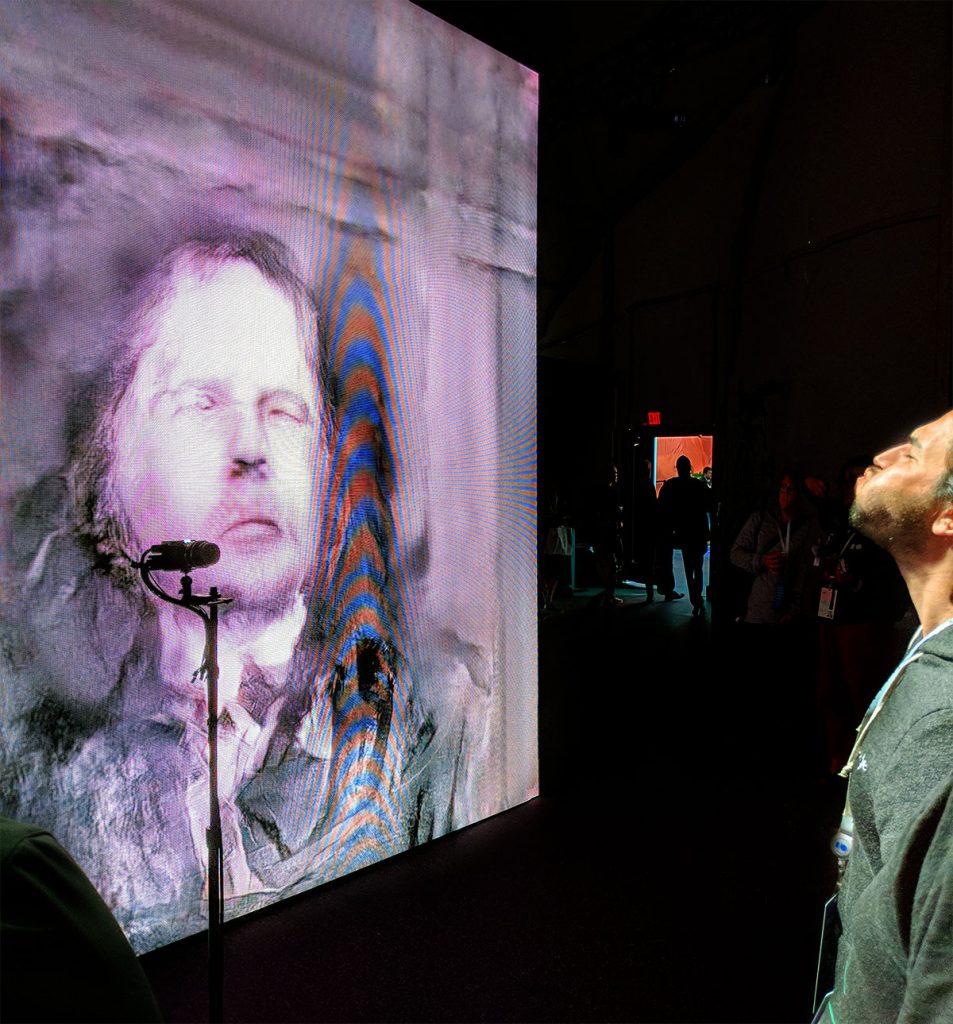
[video src=https://www.youtube.com/watch?time_continue=99&v=wVYJ8EwL7WA height:195 align:right] Adam Ferriss’s art installation from June 2018, Likeness, takes one person’s face and transforms it into another. It “reimagines face-filtering and remolds people’s appearances in real time.” Likeness, curated by Alex Czetwertynski, another digital artist and curator, was produced for Google IO 2018 in the Museum of Developer Art and commissioned by UCLA Conditional Studio. Ferriss began his installation by presenting the computer two sets of images: generic photographs of people, and what Ferriss calls “label maps” that “identify and highlight the different facial features, like eyes, eyebrows, jawline, mouth, and nose, present in the photographs."
All Things Fall

[video src=https://vimeo.com/125791075 height:200 align: right ]All Things Fall by Mat Collishaw and Sebastian Burton was first presented in 2014 during a solo exhibition titled “Black Mirror” at Galleria Borghese held in Rome [3]. The piece is powered by an electric motor and lit by numerous led lights placed all around the figurines which flash in repetition creating the illusion of motion. The zoetrope was originally designed in three dimensions. Each model figure was 3D printed at Sicnova 3D, a Spanish company specializing in 3D printing. The material used is not your average plastic found in most conventional 3D printers. Each of the figures are made from an ABS (Acrylonitrile Butadiene Styrene) material, which is a specialized hard plastic used for the prototype printer that created all of the individual components of the piece.
Route One

[video src=https://www.youtube.com/watch?v=G54tllj-SKI&t=6946s] Icelandic avant-rock band, Sigur Rós created Route One in 2016. This 24 hour long, TV production was intended to be broadcast live on BBC4 as well as Youtube.com. The band created this television event to accompany the release of their then newly released single, ‘óveður’. In this live-streamed youtube production, the band travels on the longest day of summer in Iceland, traversing Route One, a road spanning around the entirety of Iceland’s 1332km Ring Road.
Polarseeds

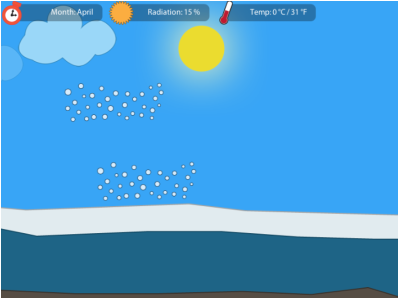 THE POLARSEEDS PROJECT: COMMUNICATING GREENLAND MELTING THROUGH VISUALIZATION AND SONIFICATION. Marco Tedesco, associate professor of earth and atmospheric sciences at the City College of New York, noted the beauty of climate science, such as flooding, cloud structure, and melting ice. To make climate science more attractive, he and his colleagues have jointly developed a research project called "Polarseeds" to present the diverse art of climate science through visual arts, music, and games.
THE POLARSEEDS PROJECT: COMMUNICATING GREENLAND MELTING THROUGH VISUALIZATION AND SONIFICATION. Marco Tedesco, associate professor of earth and atmospheric sciences at the City College of New York, noted the beauty of climate science, such as flooding, cloud structure, and melting ice. To make climate science more attractive, he and his colleagues have jointly developed a research project called "Polarseeds" to present the diverse art of climate science through visual arts, music, and games.
Deep Sleep Trawler

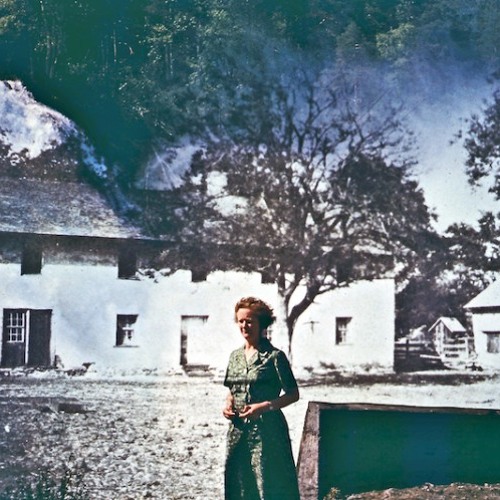 As the digital artist in residence at Forth Valley Royal Hospital in Scotland, sound artist Mark Vernon created a series of four sound art pieces, called "Bedside Radio," designed to be played over the hospital's radio station, Radio Royal. The third of these pieces, Deep Sleep Trawler, was created in 2012 "with the intention of creating a database or 'dream bank' to provide sleep deprived hospital patients with the opportunity of sharing someone else's dreams."
As the digital artist in residence at Forth Valley Royal Hospital in Scotland, sound artist Mark Vernon created a series of four sound art pieces, called "Bedside Radio," designed to be played over the hospital's radio station, Radio Royal. The third of these pieces, Deep Sleep Trawler, was created in 2012 "with the intention of creating a database or 'dream bank' to provide sleep deprived hospital patients with the opportunity of sharing someone else's dreams."
Force of Nature
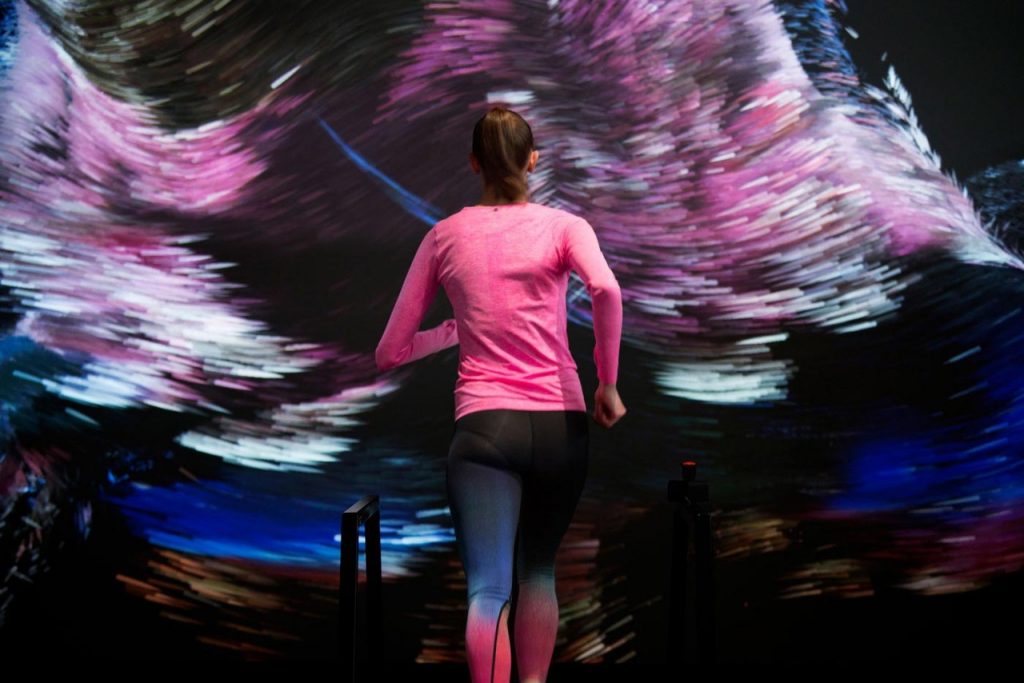
 In April 2015, Nike released its revolutionary kinetic digital art project, Force of Nature, for the Nike Innovation Summit at Truman Brewery in London. The work was created in collaboration with Field, a London-based design studio. By stepping onto a treadmill and beginning to create movement, the participating runner is presented with a fluctuating shower of stunning, multicolored sparks, similar to an energy “mirror” of themselves, created by the movement put forth by him or her on the treadmill. The flux of lights is meant to imitate the runner’s motion and turn the human body into a digital art piece. [1]. The work recalls earlier artworks, including Nancy Paterson's Bicycle TV (1989) and Jeffery Shaw's Legible City (1989-91), both of which used a bicycle as the interface by which the user's activity generates an animated video environment.
In April 2015, Nike released its revolutionary kinetic digital art project, Force of Nature, for the Nike Innovation Summit at Truman Brewery in London. The work was created in collaboration with Field, a London-based design studio. By stepping onto a treadmill and beginning to create movement, the participating runner is presented with a fluctuating shower of stunning, multicolored sparks, similar to an energy “mirror” of themselves, created by the movement put forth by him or her on the treadmill. The flux of lights is meant to imitate the runner’s motion and turn the human body into a digital art piece. [1]. The work recalls earlier artworks, including Nancy Paterson's Bicycle TV (1989) and Jeffery Shaw's Legible City (1989-91), both of which used a bicycle as the interface by which the user's activity generates an animated video environment.
Song of the Phenomena
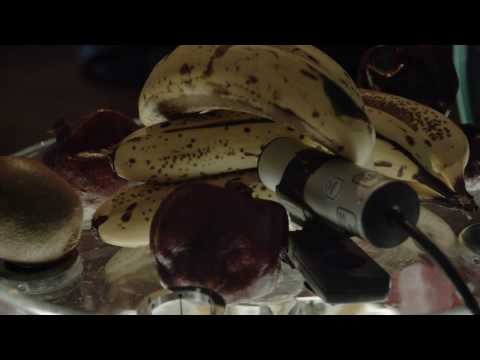
[video src=https://youtu.be/pcvVotT2XQo] Chris Henschke is an Australian digital artist who studies scientific concepts like physics, sound and light, and other phenomena. He and Mark Boland, an Australian Synchrotron physicist, collaborated on an exhibit called "Song of the Phenomena", which was displayed in the Royal Melbourne Institute of Technology Gallery in 2016. "Song of the Phenomena" includes a machine that is activated by the atomic radiating particles emitting from decomposing fruit and converted into sound. The machine was once used to calibrate radiation oncology treatments.
CAPSID

[video src=https://www.youtube.com/watch?v=l8IhFWiri5o]London-based artist John Walter spent three years studying with Greg Towers at UCL to better understand the interactions between a virus and its host, specifically HIV-1 and the effect of AIDS on the human body's immune system. His meticulous research is shown in his new multimedia project CAPSID, featuring a short film titled A Virus Walks Into a Bar, which pulls the "bar" motif of British soap operas to present an analogous tale of how HIV enters human cells and destroys them from within. Through this film – as well as paintings and installations – Walter's work not only uncovers new ways of expressing how HIV behaves, but presents his findings in a way that the non-scientifically-inclined can understand.
Digital Instru-Mentation: Red Forest and Emblems of Ascension

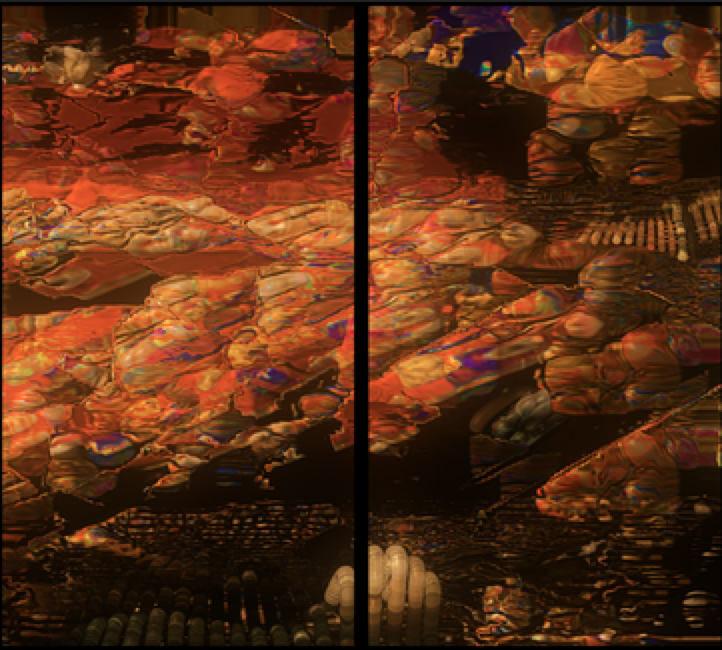 Digital art, as in the work of Robert Campbell (Red Forest, detail) and NoiseFold is achieving the plasticity of clay, paint on canvas, or even analog electronics. Several Currents 2015 participants have developed, or cobbled together, computer based tools which provide the robustness needed to dig in, explore, and experiment with contemporary new media materials and techniques. It's much like the shift from the brush of a Mannerist painter to the sponge of a Max Ernst frottage.Progress in the flexibility and robustness of digital instruments allow them to be treated as plastic media which may lead to fully collaborative human/machine systems. We can start to imagine an actual collaboration between humans and machines where, rather than participating in a one-way struggle, each contribute what they do best in a two-way dialog. And once these collaborative systems are established, their collective behavior will become more interesting than any particular 'finished work'.
Digital art, as in the work of Robert Campbell (Red Forest, detail) and NoiseFold is achieving the plasticity of clay, paint on canvas, or even analog electronics. Several Currents 2015 participants have developed, or cobbled together, computer based tools which provide the robustness needed to dig in, explore, and experiment with contemporary new media materials and techniques. It's much like the shift from the brush of a Mannerist painter to the sponge of a Max Ernst frottage.Progress in the flexibility and robustness of digital instruments allow them to be treated as plastic media which may lead to fully collaborative human/machine systems. We can start to imagine an actual collaboration between humans and machines where, rather than participating in a one-way struggle, each contribute what they do best in a two-way dialog. And once these collaborative systems are established, their collective behavior will become more interesting than any particular 'finished work'.
Two Women
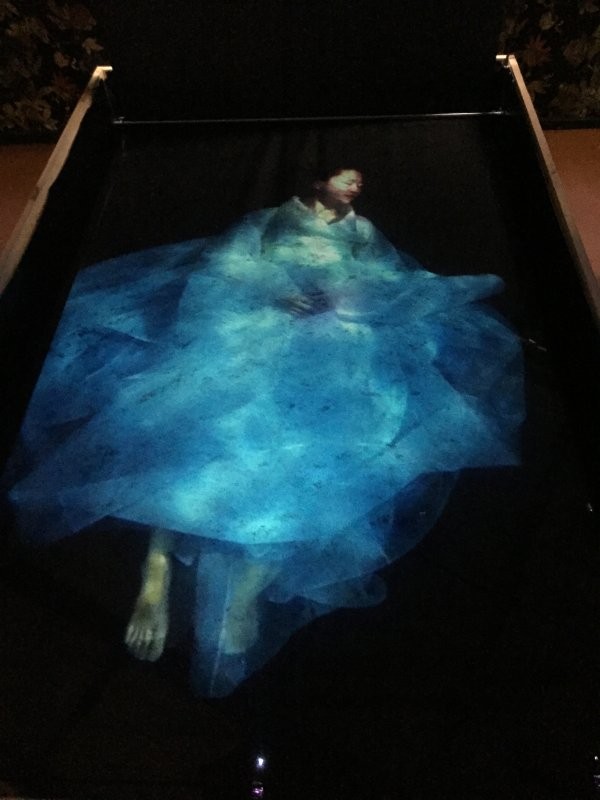
 Two women: one is young, angelic, billowing and dream like; the other alternates between the fetal position and the floating corpse pose. Side by side, the wood framed vessels into which the the images are projected and submerged in water, read as both boat and coffin. Like flowers dropped from the installation’s peeling wallpaper or the Chinese screens described by the narrator as she recounts a dream that turns into a nightmare, the water is the source of life of death. In Two Women, the gasping for air is visceral as the older woman contorts her body and I, the witness, listen to her story in Korean, read it in English and hear the stylus punctuate it into fabric as Morse code, the universal language associated with distress.
Two women: one is young, angelic, billowing and dream like; the other alternates between the fetal position and the floating corpse pose. Side by side, the wood framed vessels into which the the images are projected and submerged in water, read as both boat and coffin. Like flowers dropped from the installation’s peeling wallpaper or the Chinese screens described by the narrator as she recounts a dream that turns into a nightmare, the water is the source of life of death. In Two Women, the gasping for air is visceral as the older woman contorts her body and I, the witness, listen to her story in Korean, read it in English and hear the stylus punctuate it into fabric as Morse code, the universal language associated with distress.
The Event of a Thread

Ann Hamilton's 2012 piece, "The Event of a Thread," was a massive art installation that spans the entirety of the Park Avenue Armory in New York City. The work was meant to respond and interact with the space's architecture and internal structures, as well as to be interactive with the audience. The space was divided, […]
The Clock

Ironically it took the passing of several years for Christian Marclay’s montage The Clock (2011) to come together. The twenty-four hour long cinematic timepiece is a carefully assembled series of film clips centered on the subject of time, and all the while in synch to real time. [1] One may ask, “What makes Marclay’s montage […]
Inorganic Flora

Combining the delicate, intricate folds of nature with the hard, clinical use of computer algorithms, artist Macoto Murayama digitally sculpts flowers that he painstakingly dismantles in order to further understand their structures. Working mostly in Japan, Murayama is a botanist, as well as an artist, who attended Miyagi University in 2007, and went […]
Sound Bites City

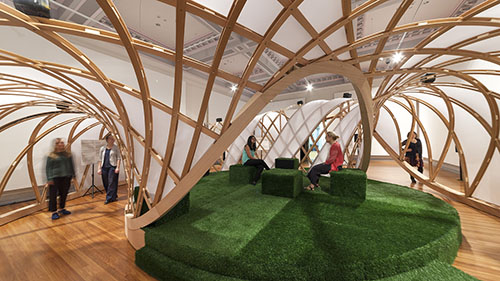 Sound Bites City is a collection of sound art from 19 sound artists from around the world at the RMIT University in Australia. Exhibited at the RMIT University Gallery, the sound art is played through speakers that are scattered around a round physical structure that culminates with a raised, faux, grassy knoll. This space is called the Torus. RMIT University describes the Torus as “an exciting circular structure that has been specially designed by architects, engineers and sound designers based in RMIT’s SIAL unit to provide the best way to exhibit sound.”
Sound Bites City is a collection of sound art from 19 sound artists from around the world at the RMIT University in Australia. Exhibited at the RMIT University Gallery, the sound art is played through speakers that are scattered around a round physical structure that culminates with a raised, faux, grassy knoll. This space is called the Torus. RMIT University describes the Torus as “an exciting circular structure that has been specially designed by architects, engineers and sound designers based in RMIT’s SIAL unit to provide the best way to exhibit sound.”
Net Blow-Up

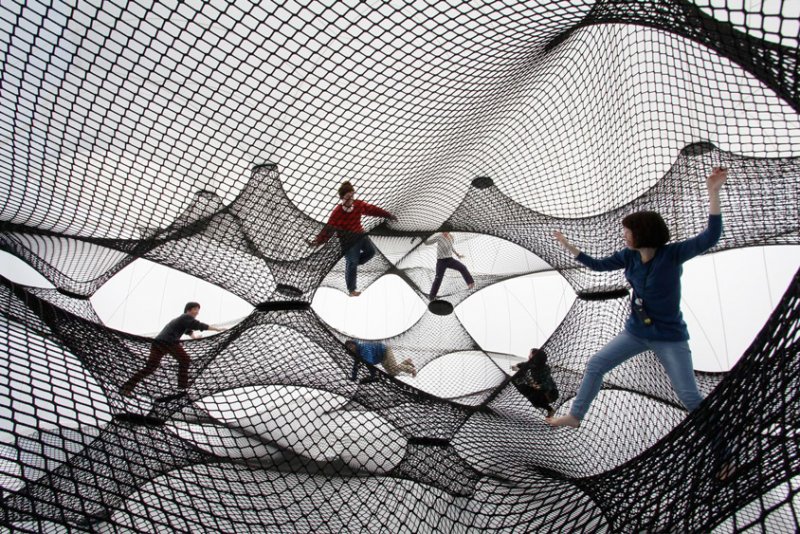 The Net Blow-Up exhibit, by croatian-austrian design collective Numen/For Use, is a highly interactive sculpture evoking nostalgia from the bouncy-castles of our youth. “Although the history of art has cultishly celebrated the individual genius, the field increasingly has recognized the importance of exhibitions, institutions and communities in shaping the production, reception and historical contextualization of art.” [1] This collaborative effort is humble, playful and simple in a way that is a necessary counterpoint to the pretentiousness that feeds the majority of modern art. I do not intend to belittle the cutting edge; I just mean that without exhibits like Net Blow-Up the world of art would be a lot less fun.
The Net Blow-Up exhibit, by croatian-austrian design collective Numen/For Use, is a highly interactive sculpture evoking nostalgia from the bouncy-castles of our youth. “Although the history of art has cultishly celebrated the individual genius, the field increasingly has recognized the importance of exhibitions, institutions and communities in shaping the production, reception and historical contextualization of art.” [1] This collaborative effort is humble, playful and simple in a way that is a necessary counterpoint to the pretentiousness that feeds the majority of modern art. I do not intend to belittle the cutting edge; I just mean that without exhibits like Net Blow-Up the world of art would be a lot less fun.
Ominous


“Ominous” is an audio-visual performance by Marco Donnarumma in which the artist uses his body to compose sound pieces using a device that records his movements. The piece was commissioned by the European Conference of Promoters of New Music (ECPNM) for the occasion of the 5th Live Electronic Music Project Competition. It premiered on 3rd November 2012 at the World’s New Music Days, and since then has been performed at various other venues such as National Academy of Arts in Bulgaria, New York Electronic Arts Festival, etc [1].
Mechanical Parts

[video src=http://vimeo.com/78771257 align: right height: 220] Mechanical Parts is a series of illustrations drawn by a robot programmed by artist Matthias Dörfelt. His machine, named ‘Robo Fabers,’ rolls across the paper and creates drawings autonomously, while adhering to a set of… interesting guidelines Dörfelt programmed it with. As he told Gizmodo, “basically [Robo Fabers] is doodling connectors—think of it as robot genitalia—as a first step of planing reproduction.” The machine randomly arranges various permutations of components as specified by Dörfelt. Most noticeably, shapes clearly resembling hairy and shorn testicles, phalluses, sperm, holes, and eggs are are visible in the drawings pictured above.
A Bell for Every Minute

[video src=http://www.youtube.com/watch?v=8nymgN5MuDI align: right height: 220] A Bell for Every Minute is a sound installation by artist Stephen Vitiello, located on the High Line in New York City. Vitiello recorded 59 bells from all over New York City. These include landmark bells such New York Stock Exchange bell, the Dreamland Bell, the United Nation’s Peace Bell, and more common, everyday bells such as bike bells, diner bells, and church bells. Vitiello placed speakers throughout the 14th Street Passage, a tunnel between West 13th and West 14th Streets. Each minute, a bell rings from the speakers. At the top of each hour, all of the different bells ring at once in a chorus that fills the space.
Rain Room

[video src= http://www.youtube.com/watch?v=EkvazIZx-F0 align:right height:220] Rain Room is an interactive installation piece created by rAndom International, a multimedia artistic team based in London. This artwork seeks to emulate the experience of rain in an indoor setting; within a large room, drops of water fall from the ceiling, creating a constant, thunderous downpour. When a person is introduced to this space, they are monitored by 3D depth cameras that inform Rain Room’s software system of the person’s exact location, causing the rain directly above the individual to cease. As a result of this technology, a person remains dry as they move throughout the space.
Sonic Water

 “Sonic Water,” by artists Sven Meyer and Kim Pörksen, is an interactive cymatic installation that explores the visualization of sound though water. The audience can walk up to a container of water, which is set atop speakers, and introduce their own input sound: voice, a song recording, or another sound source. The result of these sound vibrations is unique patterns in the water that are photographed from above. This exhibit is an interesting example of how feedback can create and alter a physical medium to visualize something so invisible as sound.
“Sonic Water,” by artists Sven Meyer and Kim Pörksen, is an interactive cymatic installation that explores the visualization of sound though water. The audience can walk up to a container of water, which is set atop speakers, and introduce their own input sound: voice, a song recording, or another sound source. The result of these sound vibrations is unique patterns in the water that are photographed from above. This exhibit is an interesting example of how feedback can create and alter a physical medium to visualize something so invisible as sound.
